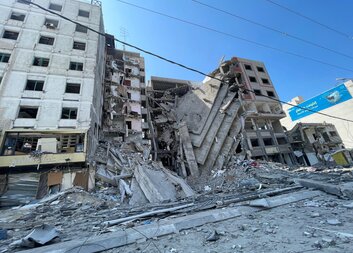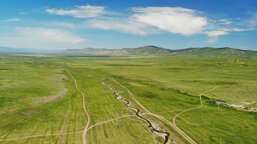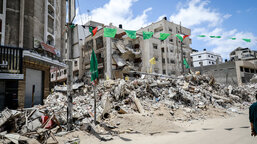Did you know that militaries are responsible for 5.5% of global greenhouse gas emissions? Wars and conflicts not only have a devastating impact on people's lives, but also negatively affect the environment and contribute significantly to climate change. By the Ukraine war’s third year, total war-related emissions generated are roughly equal to the annual emissions of several mid-sized European countries combined. In Gaza, the destruction of ecosystems is being referred to as ecocide and a war crime. In the future, the reconstruction of post-war areas will also present a problem.
Wars and their impact on the environment
During wars and armed conflicts, environmental protection is not usually considered. In conflicts where innocent civilians die every day, the focus is understandably on saving lives and providing humanitarian aid. However, the catastrophic impact of military conflicts on ecosystems should not be forgotten either.
How does the military sector contribute to climate change? Militaries consume enormous amounts of fossil fuels, which have a high carbon footprint. The global military carbon footprint is the fourth highest, ranking behind the US, China and India. If the US military alone were counted as a separate country, it would be among the biggest polluters of our planet.
Some military emissions are not necessarily specific to wartime, but they increase significantly during combat. Among the largest sources are jet fuel for planes and diesel for tanks and naval ships. Other sources are the production of weapons and ammunition, or the deployment of troops. And of course the havoc wreaked by bombing, including fires and smoke. There is also a huge increase in demolition material and rubble from the wreckage of buildings during conflicts. Destroyed buildings represent a huge amount of difficult-to-recycle construction waste. Waste management in countries affected by war often lagged behind even before the outbreak of conflicts.
Wars also destroy wildlife and biodiversity. The collateral damage of conflict can kill up to 90 percent of large animals in an area. In many places, local endangered species are threatened with extinction. In addition, wars cause pollution that contaminates waters, soil and air, making life unsafe for people. When wars and conflicts break out, people flee to safety either within their own country or across borders. Migration waves like these also place a significant burden on the environment.
The world's militaries are responsible for 5.5% of global greenhouse gas emissions. Yet many governments do not provide data on emissions from military activities, so the figure may be significantly higher. Already, military conflicts produce more annual greenhouse gas emissions than the aviation and shipping industries combined. But the documentation of military emissions has long been overlooked. It was only with the start of the Russian invasion of Ukraine that the first attempt was made to comprehensively document and assess greenhouse gas emissions during wartime conflict.
The war in Ukraine produced more emissions than the entire Czech Republic
According to the latest estimates, the greenhouse gas emissions caused during the three years of war in Ukraine amount to the equivalent of 230 million tons of carbon dioxide emissions. This is equivalent to the annual emissions of the Czech Republic, Austria, Hungary and Slovakia combined. In the total amount, the experts included all the emissions that arose from warfare during the war or will arise from repairs to what the war destroyed during the first year.
This is still not a complete carbon footprint. The researchers say they were able to make a good estimate of emissions caused by forest fires or future emissions associated with repairing destroyed infrastructure. The problem arises with emissions caused by military vehicles, where the numbers tend to be underestimated due to a lack of information. The largest share (42 percent) of war-related emissions comes from demolition and future repair of buildings and infrastructure. This is followed by emissions associated with the war itself, which includes not only fossil fuels but also the construction of fortifications, munitions production and fires caused by combat.
Ecocide in Gaza?
Not only the war in Ukraine, but also the ongoing war in Gaza is having a devastating impact on the environment. First months of conflict produced more planet-warming gases than 20 climate-vulnerable nations do in a year. According to research, the vast majority (over 99 percent) of the greenhouse gas emissions can be attributed to Israel’s aerial bombardment and ground invasion of Gaza. In an area where living conditions are already disastrous for the local population, attacks on ecosystems are making the situation many times worse.
Relentless bombardment and military bulldozing razed vast portions of Gaza’s landscape. Over two-thirds of Gaza’s farmland (including orchards, olive groves, wells, and greenhouses) has been damaged or destroyed. Satellite imagery indicates that between 38% to as much as 80% of all trees and vegetative cover were wiped out during the assault. Vital ecosystems – sand dunes, coastal lagoons, and the Wadi Gaza wetland – have been extensively scarred. This loss of trees and vegetation has stripped fertile topsoil and could lead to long-term desertification in what was once a biodiverse, well-watered land.
Environmental and human rights organisations have long highlighted not only serious human rights violations but also environmental destruction and have called for the damage in Gaza to be declared an ecocide and investigated as a possible war crime. Ecocide is generally considered to be a particularly serious crime against the environment. That is, widespread and serious damage to the environment or ecosystems.
The Gaza Strip was already experiencing climatic consequences such as sea level rise, drought and extreme heat, even before the escalation of the conflict. Much of the agricultural land, energy and water infrastructure has been destroyed or polluted, which will have devastating health consequences for decades to come. More than half of all buildings in Gaza have also been destroyed - yet house building is a major contributor to global warming.
Reconstruction and the post-war period
Once the war conflicts are over, the areas will need to be rebuilt. The construction and rehabilitation of infrastructure brings with it large emissions. This includes cement production, which is demanding in terms of carbon dioxide emissions, but also the controlled firing of unused munitions, which leads to further pollution. In Ukraine alone, rebuilding the war-torn infrastructure will mean the release of 200-400 million tonnes of CO2.
Not only the restoration of buildings, but especially the restoration of the environment will take many years, depending on the specific type of fighting and its duration. Once active fighting ceases, there is a risk of widespread desertification and loss of land due to lack of water.
The environmental impact of wars is enormous. Emissions from wars have a significant negative impact on climate change and threaten our climate security. It is therefore important to take them as seriously as other consequences of war conflicts, such as humanitarian crises or economic damage.
Caritas Czech Republic helps to protect the environment and help people in disadvantaged regions adapt to climate change. We also help in areas affected by conflict and war, thanks to the generous support of our donors.













